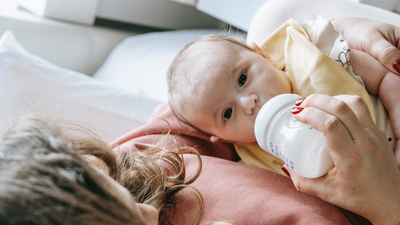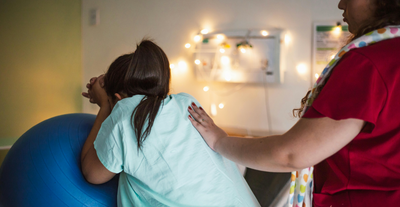How is Breast Milk Antiviral?
How is Breast Milk Antiviral?
by Katie Black
There’s still so much we don’t know about breast milk, but each new discovery is a testament to its amazing abilities. For example, you may have heard that breast milk is antiviral.
But what does that really mean?
During the COVID pandemic, there was a big boost in research on breast milk and its role in an infant’s immune system. This scientific review from 2021 in the journal Nutrients looks at what we currently do and don’t know about the antiviral and antibacterial properties of breast milk. Here’s a summary:
(There'll be quite a few terms to keep track of so here's a glossary you can refer to while reading.)
A newborn’s immune system
Newborns are super vulnerable to illness and infection because their immune systems are so new.- Innate immune system:
Newborns have some innate immunity cells at birth but they’re either smaller in number, or less functional compared to older people.
- Adaptive immune system:
In utero, a baby doesn't come in contact with many antigens because mom’s body does a great job keeping them away. This means newborns haven’t had a chance to develop ways of dealing with antigens which is why they have a weaker adaptive immune system.
All of this means newborn babies need more protection to stay safe and healthy. This is where breast milk swoops in.
Breast milk’s evolution
Breast milk has actually evolved to meet a newborn’s immunity needs! It focuses on things babies are lacking like antibodies, antibacterial and antiviral compounds, and other things that boost immunity. In fact, breast milk is so protective, some scientists think that the mammary gland actually came from the immune system! Some evidence for this is that colostrum (the milk a mom makes right after giving birth) has a role in building immunity even before it starts playing a role in nutrition.Babies that are exclusively breastfed generally have stronger immune systems and healthier microbiomes compared to those who aren’t.
The microbiome
This is all the microorganisms that live on and inside our bodies, both good and bad. There are three subsets of the microbiome.Bacteriome:
The collection of bacteria living in or on the human body. Many of these bacteria benefit us and are important for digestion.
Virome:
You guessed it - the collection of viruses that live in our bodies and in our genes. Some viruses can cause diseases like the flu or common cold, while others actually help the immune system or target harmful bacteria.
Mycobiome:
This one’s trickier to guess … the fungi that live in the human body. Some fungi in the mycobiome are beneficial, while others can cause infections or diseases, especially in those of us with weak immune systems.We’ve known how important the bacteriome is for a while, but recently scientists are discovering more about the importance of the virome. There are these things called bacteriophages, viruses that use bacteria to work, and they play a key role in keeping a check on bacterial growth. There’s more and more evidence that breast milk not only has good bacteria, but also good viruses while filtering out harmful ones!
So while this post focuses mostly on the antiviral and antibacterial properties of breast milk, keep in mind it also has viruses and bacteria babies need for making the microbiome.
Bioactive and antimicrobial compounds

Bioactive compounds are found in food and benefit our bodies in ways beyond nutrition. We don’t fully understand these compounds, especially with how they work together, but scientists do have some idea on what’s going on with certain ones.
Antimicrobial compounds is an umbrella term for bioactive compounds that help prevent or fight illness that comes from bacteria, viruses, or fungi.
Let’s take a deeper look at some specific ones in breast milk:
Related reading: How Does Breast Milk Change for Your Baby's Needs?
Immunity cells
These develop from stem cells in bone marrow to become different kinds of white blood cells. In breast milk, scientists have found three main groups of immunity cells. They are:- Neutrophils (25%)
- Macrophages (60%)
- Lymphocytes (10%): There are two main types of lymphocytes: B and T cells. They’re part of the adaptive immune system.

Immunoglobulins (antibodies)
The different viruses making their way around a population and into a mom’s body influence the antibodies that will be in her breast milk. Breastfeeding newborns get direct access to this ready-made pool of antibodies to fight against things that would otherwise make them sick.
One super cool idea is that a mom’s body might even make antibodies in response to microbes in her baby’s mouth via “backwash”. The way it could happen is that when a baby is breastfeeding, the suctioning makes a little bit of spit and milk to go back inside the mammary gland. Mom’s body will then recognize the pathogens in that and make the right antibodies in response. Fascinating!
Breast milk is also rich in something called secretory IgA (sIgA), with 10–100 times more than what’s found in blood! This antibody has double the anti infection powers. First, it protects us from a bunch of microbes, and second, it manages immunity in the intestines. The huge amount of sIgA in breast milk can coat a newborn’s gastrointestinal tract, stopping some microbes from being able to bind to it.
The IgAs in breast milk bind with bacteria and hinder them from growing in the newborn’s intestine. A short supply of this powerful antibody can lead to bacteria overgrowing and inflammatory diseases like necrotizing enterocolitis.
Cytokines
These are small proteins that act as communicators between cells, and signal a bunch of different immune responses when they’re needed. In breast milk, there’s a huge variety of cytokines, both anti-inflammatory and inflammatory.Within the inflammatory cytokines, you’ll find something called the Transforming Growth Factor-β (TGF-β). This has really fancy and capable ways of tracking the immune system, plus it's antiviral. It even manages the production of IgA. Some studies even show that if a mom is exposed to a lot of microbes, her breast milk has higher levels of TGF-β, suggesting they could be there to protect her baby.
Fatty Acids
There are lipids (fatty compounds) in breast milk. Enzymes in a newborn’s saliva or stomach break them down into different parts like free fatty acids. Free fatty acids can be antibacterial and antiviral. In particular, long-chain polyunsaturated fatty acids seem to show the most antimicrobial activity, both against bacteria and viruses. In fact, when they see an infection, the lipids can supply more of these fatty acids, particularly DHA, ALA, and EPA.
Want to know what’s in your milk? Order a personalized test here
Proteins:
You might have heard of lactoferrin. It’s quite the celebrity after getting a lot of attention recently for its potential power against COVID.
You guessed it again; it’s even in breast milk. Lactoferrin can bind to the iron in milk, keeping bacteria from using it to grow.
Lactoferrin even fights viruses like herpes simplex, HPV, HIV, and rotavirus. It does so by stopping viruses from entering our cells in two main ways. It will attach to viruses directly or where they attach on host cells to stop them from sticking to and infecting host cells.
Tenascin-C is another protein found in breast milk that’s shown a special ability to fight viruses, including HIV. It does this by connecting with a part of the virus's outer layer, basically stopping it from infecting cells and spreading through breast milk. It seems to be even stronger than lactoferrin and similar to some HIV-fighting antibodies. Tenascin-C's power also comes from how its structure works with the virus's outer layer. This suggests it might also work against other viruses like the flu.
Mucins
They’re large molecules with sugars on them, found in a bunch of body fluids. The more mucins, the thicker the fluid. Two types of mucins, MUC1 and MUC4, are found in breast milk. They’ve been shown to fight viruses like HIV and influenza.
The sugar molecules attached to MUC1 and MUC4 bind to viruses, trapping them and stopping them from reaching a cell’s surface.
When a mom has an infection like the Zika virus, the mucin content and thickness of her breast milk might increase, giving newborns extra protection.
Human milk oligosaccharides
Lastly, human milk oligosaccharides (HMOs) are a group of carbs that support the immune system in a bunch of ways. Initially they were known for their role in creating the microbiome in babies. They’re now also known as super important prebiotics (compounds in food that nourish good bacteria) for gut health.Recent research has also shown them to have a direct antiviral function. They can stop the binding of certain viruses to host cells, including norovirus, HIV, influenza virus, and rotavirus. Their structure looks a lot like different surfaces viruses try to bind to, allowing HMOs to act as “decoys” that bind to the virus instead and stop them from entering cells.
Conclusion
Breast milk is made up of an awesome number of things, and how all these substances and pathogens play with each other is hard for scientists to piece together. So keep in mind none of this info is conclusive or complete.The main takeaway is how incredibly diverse and adaptive breast milk is, and the huge role it plays in making and regulating a baby’s immune system.
At Lactation Lab we firmly believe that fed is best, but if you’re on the fence about breastfeeding we want you to have all the facts. You can order a breast milk test kit here for a personalized “food label” or join The Lactation Lounge, a breastfeeding support group of moms that will be there for every step of your journey. It’s monitored by our very own team IBCLC, Ashley. So ask us any questions you have.

Sources:
https://royalsocietypublishing.org/doi/10.1098/rspb.2014.3085
The Antiviral Properties of Human Milk: A Multitude of Defence Tools from Mother Nature - PMC
https://www.pexels.com/photo/mother-breastfeeding-her-baby-4226827/
https://unsplash.com/photos/woman-holding-laboratory-appratus-LiNIONbajm4
https://www.pexels.com/photo/microscopic-shot-of-a-virus-3992945/
https://unsplash.com/photos/baby-lying-on-white-bed-xEQObOlsfg8






